Xinjiang: What a Fairyland!
A fresh breeze brushes the vast pasture, taking the aromas of milk, tea and wine to places far away, together with the scent of soil, neighing of horses, and the songs of shepherds.
The grassland is a place of paramount beauty tourists yearn for, and a beautiful home where multiple ethnic groups live and work together.
So, what potential and vitality does a place like this hold? And what are the stories that it can tell? Unless through in-depth communication with the locals, one may never unveil the mystery of these magnificent grasslands.
To this end, Guangming Daily sent research teams to five Chinese regions famous for vast pastures: Xinjiang, Qinghai, Tibet, Inner Mongolia, and Gansu.
From today on, the teams' findings will be compiled into theOn the Wild Pasture series, and present to our readers the most authentic stories from the grasslands.
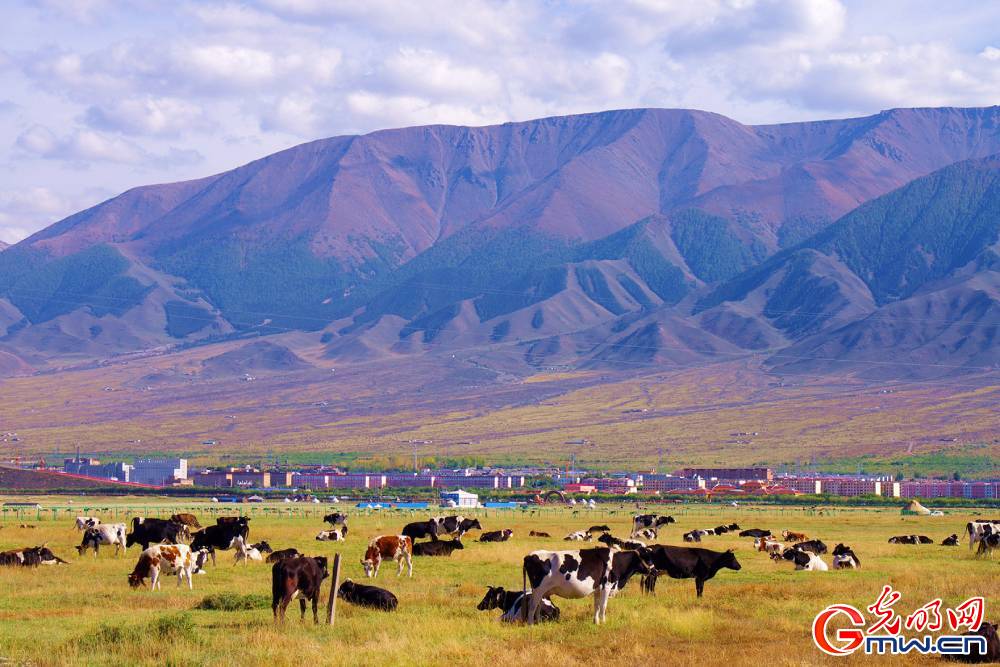
Herds of cattle and sheep are seen on the Barkol grasslands in northwest China's Xinjiang Uygur Autonomous Region on Sept 12, 2021. (Photo/Guangming Picture)
Lo and behold, this is Xinjiang in autumn:
In the endless golden yellow of Kurustai grassland, sheep are fat and cattle are strong; in the Grape Valley at the foot of the Huoyan Mountain, crystal “pearls” and purple “agates” get crowded on the vines; in the wilderness of Atushi grassland, ripe figs sway in the wind, and the wind kisses the boundless verdant waves; and in Kashgar, branches of pomegranate trees in small village yards are bent by heavy fruits ...
In July, Communist Party of China General Secretary Xi Jinping paid a visit to Xinjiang, where he told teachers and students, villagers, and community residents that “We (people of different ethnic groups) should be like pomegranate seeds”. Before he even finished this line, from the crowd of hundreds burst out the loud reply of “Bonding Together”.
The smiling faces of the crowd attest to this vivid analogy. Yes, the peace, stability and vitality that people see in today’s Xinjiang derive from the strength of ethnic unity.
In Xinjiang, the Guangming Daily Research Team witnessed first-hand the profound changes driven by the CPC’s governance strategy in the new era.
Ethnic Unity Like Overlapping Petals
The people that have been through storms are those who feel most dearly the value of ethnic unity.
The Tacheng Prefecture in northern Xinjiang was officially established during the Qianlong period of Qing Dynasty and was a multi-ethnic settlement from the very beginning. Now, out of 330,000 families in the prefecture, 11,000 are made up of two or more ethnicities.
At the home of Halidan Yilahun, a role model of ethnic unity in the Haldun neighborhood, we met the team of Prof. Luo Yi from Xinjiang Normal University who were conducting a field survey.
One of his team members, Uygur student Alifeire Momin, told our reporter that Haldun is a multi-ethnic neighborhood formed after hundreds of years of interracial exchanges and cultural, economic and social mingling. The team called it the “Tacheng Model” of ethnic unity, nicknamed “overlapping petals”.
On September 20, 2020, a special wedding was held in the courtyard of Halydan Yilahun, where her daughter Muharam Mijti and her childhood friend Parmuk Tarati tied the knot. Relatives celebrated the wedding with folk songs and dances, expressing their best wishes to the bride and groom.
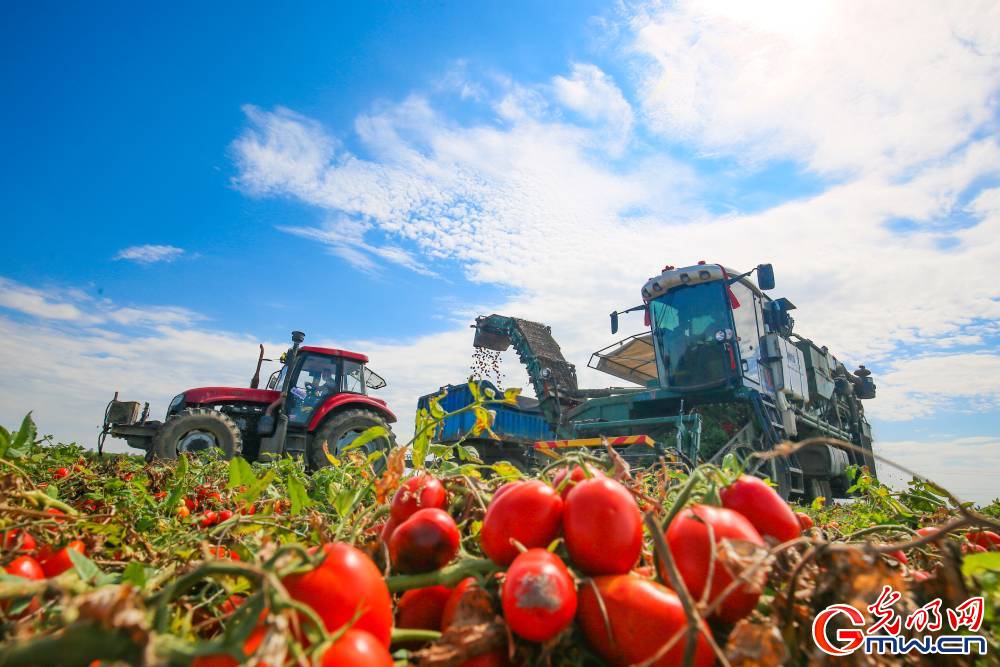
Farmers use tomato harvesters to harvest tomatoes in Xihu Village, Wugongtai Town, Hutubi County, Changji Hui Autonomous Prefecture, northwest China's Xinjiang Uygur Autonomous Region, Aug. 27, 2022. (Photo/Guangming Picture)
We saw a group photo of the wedding in the exquisitely decorated Russian-style house of Halidan, whose 19 family members come from six ethnic groups: the Uygur aunt, the Uzbek uncle, the Tatar brother-in-law, the Kazakh brother-in-law, the Russian son-in-law, and her Han brother whom her father adopted many years ago. Everyone’s face is full of love and affection. One can imagine the countless touching stories behind this picture.
Aunt Halidan told us that she really likes the multi-ethnic community of Haldun, where people live together and care for each other. They’d send each other vegetables and fruits, just like what good neighbors and friends would do.
In Tacheng, we paid a visit to Wuhas Suleiman, a doctor whose benevolence is felt in the pasture for more than 40 years, and Shalekjon Yiming, who has been raising the national flag in his yard for 12 years – their stories have touched people of all ethnicities living on this vast land.
Along the streets of the Haldun neighborhood, we saw many “pomegranate signs” hang outside the courtyards, the number of pomegranates indicates the number of ethnicities the family involves. It’s a small design that expresses the locals’ support for ethnic unity.
The Aksu Prefecture in southern Xinjiang has shown an astonishing speed of socio-economic development in recent years. More than 70% of its 2.71 million people are from minority ethnic groups, where unity and stability are like the two wings of the fast-flying region.
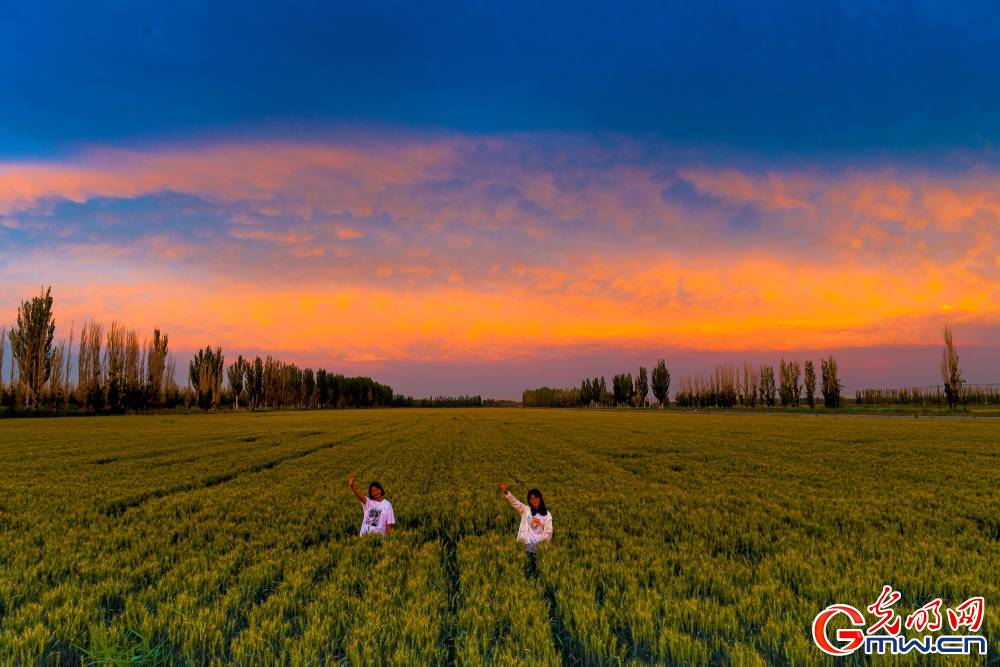
Photo taken on June 17, 2022 showshappy teenagers singing in the rosy fields of hope at the 24th Regiment of Yanqi Reclamation Area of Tiemenguan City, the Second Division of Xinjiang Production and Construction Corps. (Photo/Guangming Picture)
The “Wang San Street” in Aksu City is an example of ethnic unity. In late Qing Dynasty, a Uygur couple from Kashgar came here for business but fell ill and were treated by Wang Fucai, a doctor from Tianjin who was practicing medicine in Aksu, and they later became sworn brothers. Wang Fucai later adopted the couple’s son, named him Wang San and taught him medicine. Later, Wang San became a famous local doctor, and people named the street “Wang San Street” in his honor.
In January 2018, the “One Family Restaurant” was officially opened on Wang San Street with 88 shareholders from 7 ethnic groups. Wang San’s grandson, Mehmet Toghuti, is one of the shareholders, who also has a Han Chinese name Wang Weihan. The shareholders agreed at the very beginning to designate 5% of the restaurant’s profit to helping people in need, a decision made to pass on the spirit of ethnic unity of Wang San’s family.
The dining area has more than 1,400 square meters on two floors, and guests are treated everyday with boiled lamb, baked buns and other folk dishes, and traditional Han dishes such as braised fish and hotpot are increasingly popular with Uygur gourmets, making the restaurant a bond of ethnic integration.
It has now become the consensus of Aksu people that only by striding ahead hand in hand and with one mind can they create a better future. Among the locals, there is never a shortage of such stories.
Zhao Wuzhong was a migrant worker who came to Aksu’s Wensu County from Sichuan’s Nanchong some 20 years ago. He later started his own orchard business but soon ran into operational problems. At the hardest moment, a Uygur friend named Mohetar lent him 10,000 yuan and bailed him out of his difficulties. The two then partnered and created a successful walnut business. Today, they are known among locals as the “walnut brothers”.

Fruit farmer drys peeled and cleaned walnuts in Kalkujak Village, Bagtoglak Township, Awati County, Aksu Prefecture, northwest China's Xinjiang Uygur Autonomous Region, Aug 27, 2022. (Photo/Guangming Picture)
Liu Daohao is a young fellow from Bengbu of Anhui Province who loves to eat roast lamb. Seven years ago, he met Yasen, a Uygur barbecue peddler, and they moved to Aksu’s Kuche City and started a barbecue restaurant. Today the restaurant has become a must-go place in the city’s night market. The locals call the owners of the restaurant “barbecue brothers”.
Ethnic unity stands at the very core of the successful joint-venture business of these two pairs of brothers.
At 6 o’clock in the afternoon before the sun sets behind the hills of Ili City, the Kazakh song “Moonlight on the Ili River” comes into your ears with a fresh breeze. The lilting accordion sound goes along with the beautiful lyric, “by the banks of the Ili River stand small poplars, the leaves rustle in bright moonlight”.
Following the beautiful melody, we entered the Alexander Accordion Museum in Yining, Ili Kazak Autonomous Prefecture. Its owner, Alexander Sergeevich Zazorin, is an ethnic Russian whose family has lived in Yining since his grandfather’s generation. He learned accordion at the age of 10 and started to repair it at the age of 15, and has collected more than 800 accordions from all over the world over the past four decades. In Ili City, there is an accordion band consisting of 20 members from 13 ethnic groups.
The performance that we saw that afternoon was presented by Alexander and musicians from seven ethnic groups, including the Xibo, Kazakh, Kirgiz and Mongolian. Nostalgic and affectionate songs such as “Me and My Motherland”, “The Girl from Darbancheng”, “Flower and the Lad”, “Gadamerlin”, and “Black Walking Horse” attracted a huge crowd and won loud applauses.
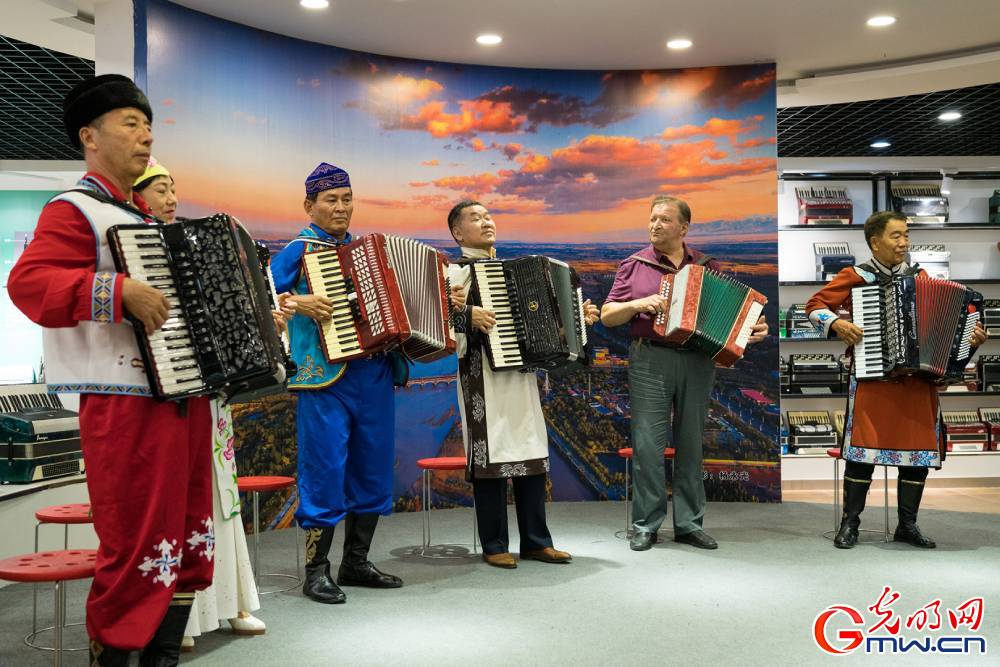
Photo taken on July 21, 2022 shows musicians from seven ethnic groups playing accordions at the Alexander Accordion Museum in Yining, Ili Kazak Autonomous Prefecture, northwest China's Xinjiang Uygur Autonomous Region. (Zhang Andi/Guangming Picture)
Band leader and Xibo musician Guo Shunmin said, “The accordion has a beautiful tone, and we wish to play the song of national unity for more people with the accordion.”
Immersed in the enchanting melody, we applaud not only their great performance but also the hospitable Aunt Halidan, the “walnut brothers” and the “barbecue brothers”, as well as the analogy of “overlapping petals” drawn by Prof. Luo Yi’s team. Indeed. The ethnic unity in Xinjiang deserves a long and loud applause.
Concerted Efforts for Ethnic Harmony
Throughout history, Xinjiang has been a shining pearl along the ancient Silk Road and a gateway for East-West communication. Since time immemorial, Xinjiang has been a place where multiple and diverse cultures co-exist in harmony.
Standing in front of a sand miniature at the Khorgos Culture Exhibition Hall, we felt strongly the ambition and magnitude of the Silk Road Economic Belt. Today, as a gateway of the Belt and Road Initiative, Khorgos is regaining its historical glory.
Gulibahar Galmukhaz, head of the land port of Khorgos Economic Development Zone, told us that over 6,000 China-Europe Express Trains traveled through the port in 2021, accounting for 50% of the four railway ports in China. The port is a microcosm of how Xinjiang has benefited from the Belt and Road Initiative.
Our trip was also a tribute to the history of Xinjiang. Through the dust of yellow sands and the thick clouds of history, we revisited the great figures who once lived on this great land.
What decorate the vast land of Xinjiang are not only the “Zuo Zongtang Willows” planted some 150 years ago in late Qing Dynasty, but also poplar trees which manifest the miracle of life. The locals call the trees “heroes in the desert” because they can live up to 1,000 years. In Xinjiang, generations of Production and Construction Corps have guarded and developed the place just like these “desert heroes”.
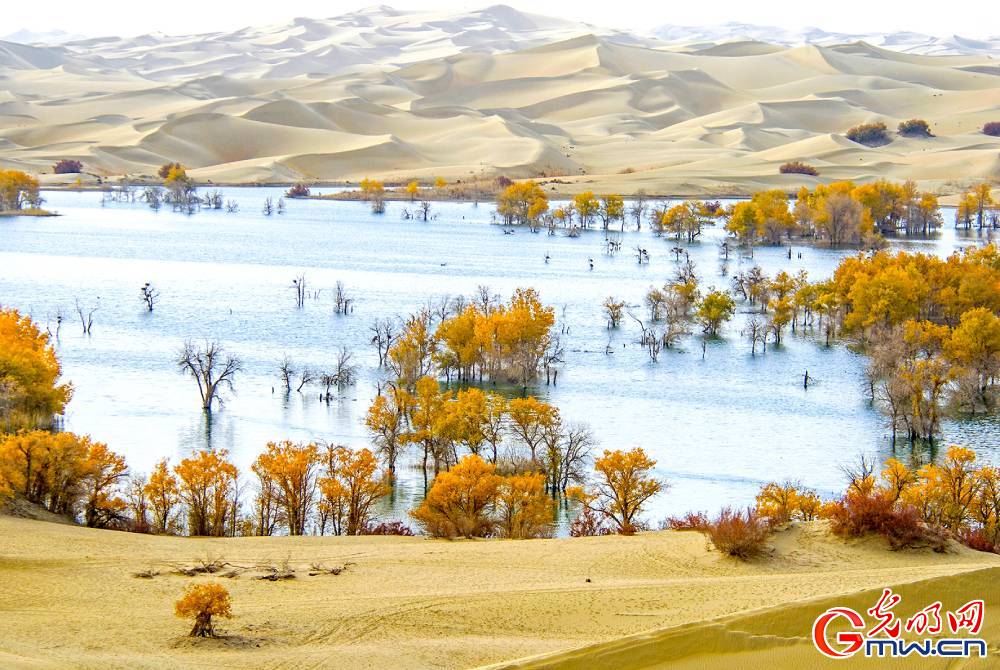
Photo taken on Oct 30, 2021 shows the beautiful poplar trees in the water at Huludao tourist spot, 33 Tarim Reclamation Regiment, Tiemenguan City, Xinjiang Production and Construction Corps 2nd Division. (Photo/Guangming Picture)
In 1954, Brigade 359 followed Chairman Mao Zedong’s instructions to lock up their weapons and engage in developing the region. Since then, many aspiring young people from the rest of China have left their hometown to join the ranks of Xinjiang Production and Construction Corps.
The Corps followed Chairman Mao’s words of “not hurting the interest of the locals”, hence most of the Corps’ facilities were built along the edges of the desert. The gales blowing with desert sands did not scare off these intrepid Chinese men and women: without means of transportation, they carried loads on their shoulders; without livestock, they pulled the plow and planted the land by themselves; without food supply, they fed on cereals with salt water and spicy noodles. Generations of the Corps were just like the willow and poplar trees in the Gobi Desert, which have taken roots and become the invincible and unmovable “boundary marks” of the country.
For 68 years, the Corps have held a hoe in one hand and a gun in the other, not only safeguarding the integrity of the country, but also driving the socio-economic development of Xinjiang. Gone are the days of cow ploughing and kerosene lamps, today Xinjiang leads the country in mechanized farming thanks to the Corps’ endeavors.

Harvesters and transport vehicles harvest tomatoes at a farm in the 10th Company of the 22nd Regiment of the Second Division of the Xinjiang Production and Construction Corps, Aug 27, 2022. (Photo/Guangming Picture)
In the early years after liberation, Xinjiang’s industry was known for only capable of producing horseshoes and hemp ropes. Modern industries started to flourish following the arrival of the Corps, who helped establish an industrial system in Xinjiang that centered on textile, steel, coal, construction materials, electric power, petrochemical and machinery industries. The time-honored enterprises such as the July 1 Textile Plant, August 1 Steel Plant and Flour Mill are among the many achievements of the Corps. No wonder scholars today believe the Corps is the founder of modern industry in Xinjiang.
As an important force for stability in Xinjiang and border security of the country, the Corps has always been loyal to its mission of “serving the people in Xinjiang”. For decades, it has safeguarded the place, mobilized resources and brought prosperity to the land of Xinjiang. In order to support industrial development in Xinjiang, the Corps has transferred some industrial and commercial enterprises to local authorities for free.
After 68 years, the Corps itself has grown considerably, too. It has not only turned desert into oasis, but also evolved from “running agriculture” to “operating cities”. Today, Shihezi, Beitun, Tumushuk, Alar, Kokdala have become famous cities along the border line.
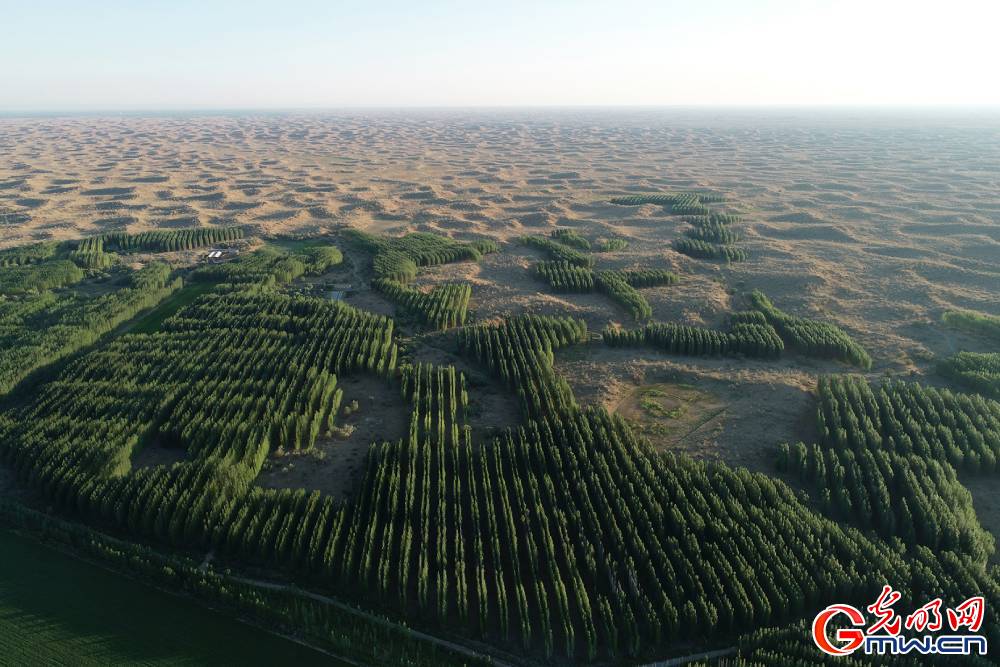
Photo taken on July 11, 2019 shows the southern edge of the Gurbantunggut Desert in Shihezi, northwest China's Xinjiang Uygur Autonomous Region. (Photo/Guangming Picture)
“The beautiful night is so quiet with only the sound of my accordion on the grassland. I want to write a letter to a girl faraway, but there is no postman that can take my love to her......”
The song “Grassland Night” from more than 60 years ago triggered enchanting imagination about Kokdala, but not many people know what the place was truly like back then.
“The place was covered with weeds and rat holes,” 93-year-old veteran Yan Xinqiu showed us a black-and-white photo. “We plowed lands in the day and squeezed in the tent at night. The winter was so cold that the bread we took was frozen like a rock”, Yan recalled.
Despite the hardships, the pride remains undiminished. In the old photos are young soldiers sitting around singing and playing accordion. It is with this fighting spirit that generations of the Corps have sealed a barren and desolate Kokdala in the depth of history forever. Nowadays, Kekodala is the Corps’ largest producer of food oil, corn seeds and livestock; and the per unit yield of corn has repeatedly refreshed the national record.
Deputy Secretary of the Corps Party Committee and Publicity Director Liu Jianming told reporters that General Secretary Xi gave full recognition of the Corps’ spirit, we must promote such spirit to further enhance ethnic unity, maintain social stability and reinforce border security.
Hearts Pulled Together by Culture
Chen Hong, a young fellow from Anhui Province kicked off his motor ride from early June to Xinjiang. His dream was to cover both sides of the Tianshan Mountains, despite the scorching heat and strong wind.
When our reporters met him in Hotan, Chen had traveled more than 9,000 kilometers. With great excitement, he showed us the photos he took along the way: the Gobi desert, snowcapped mountain peaks, and grasslands, the home-stays, bazaars and night markets, and ancient towns, garrisons and stone paintings. “It’s such a great joy to travel to Xinjiang for the beautiful scenery, the delicious food, and the splendid culture”, Chen said.
Tourism was a booming business in Xinjiang this past summer. The beauty of Xinjiang has attracted countless tourists this year. Many netizens exclaim how many of their friends are traveling in Xinjiang in the Wechat Moments they post.
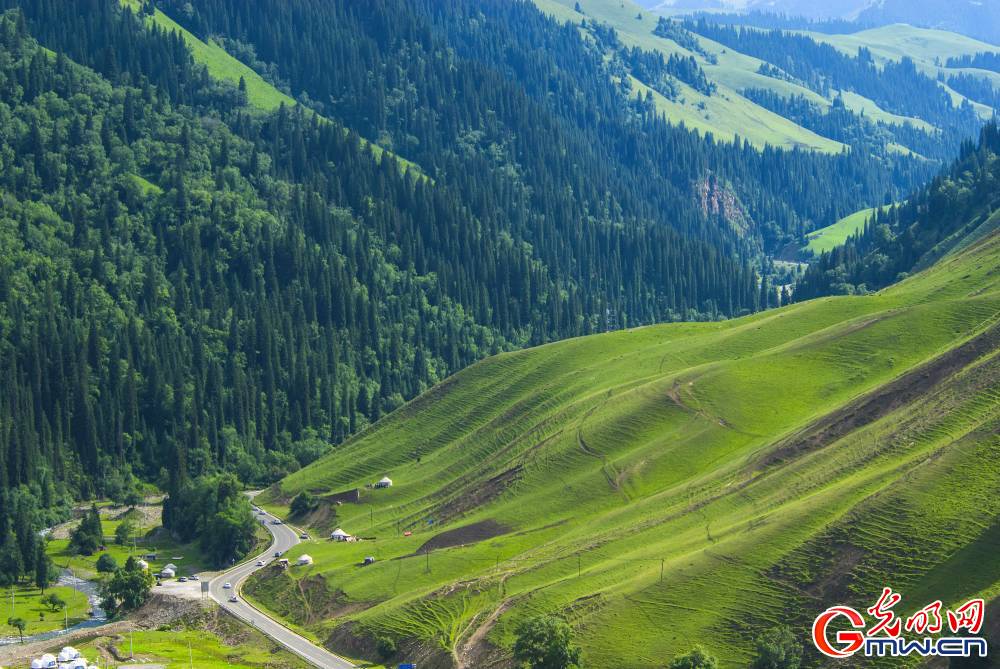
Photo taken on July 10, 2022 shows the picturesque Duku Highway in Xinjiang Uygur Autonomous Region. (Photo/Guangming Picture)
Songs and dances only represent a tiny part of the attraction because in Xinjiang, “people who can talk can sing, and people who can walk can dance”. Indeed, Xinjiang is a land overflowing with a rich culture.
As night falls, tourists from all over the country mingle with the locals in the Night Market of Hotan. The New Jade Dancing Troupe, which was established 72 years ago, entertains its audiences with well-rehearsed programs. The song “The Party’s Policy’s Wonderful”, has pushed the vibe to its climax thanks to the Uygur way of presentation that combines monologue, singing and dancing.
As the lyric goes, “What’s wonderful? What’s Wonderful? The policy of the CPC Central Committee is wonderful! Mehmet feels joyful today as we follow the direction pointed by the 19th CPC National Congress. The entire Hotan is singing as the ancient city opens a new chapter…”
Tusunjiang Abduala, deputy head of the troupe, said “Our troupe was named by Premier Zhou Enlai. We all cherish this great honor. Over the years, we have produced and performed many song and dance shows reflecting the progress of ethnic unity, which are very popular among the locals. The ‘Party’s Policy’s Wonderful’has been shown on the stage for 16 years, and it’s constantly updated to reflect the development of the times, using the form of song and dance to spread the policies of the Party such as free schooling and healthcare, poverty eradication and rural revitalization. It’s a show that people fall in love instantaneously and that’s why it’s popular both at home and abroad, and it even went to the stage of the Spring Festival Gala”.
As the ancient desert city glows with neon lights, cultural tourism has become a barometer of regional development. In the night market of Hotan, we’ve seen a new Xinjiang growing with the charm of culture.
Culture is the silent, soft power that nourishes a place. As Chinese philosophy believes, “humanity is cultivated by culture”.
Xinjiang has shown an unprecedented momentum of cultural development in recent years. The movies “The Wings of Songs”, “Why are the flowers so red”, and songs such as “You Came to Tianshan in July”, “Your Words are Our Favorites”, and the large-scale show “Lift your Headscarf - Xinjiang is a Good Place” are like spring water that nourishes the minds of people of all ethnic groups living on both sides of the Tianshan Mountains.
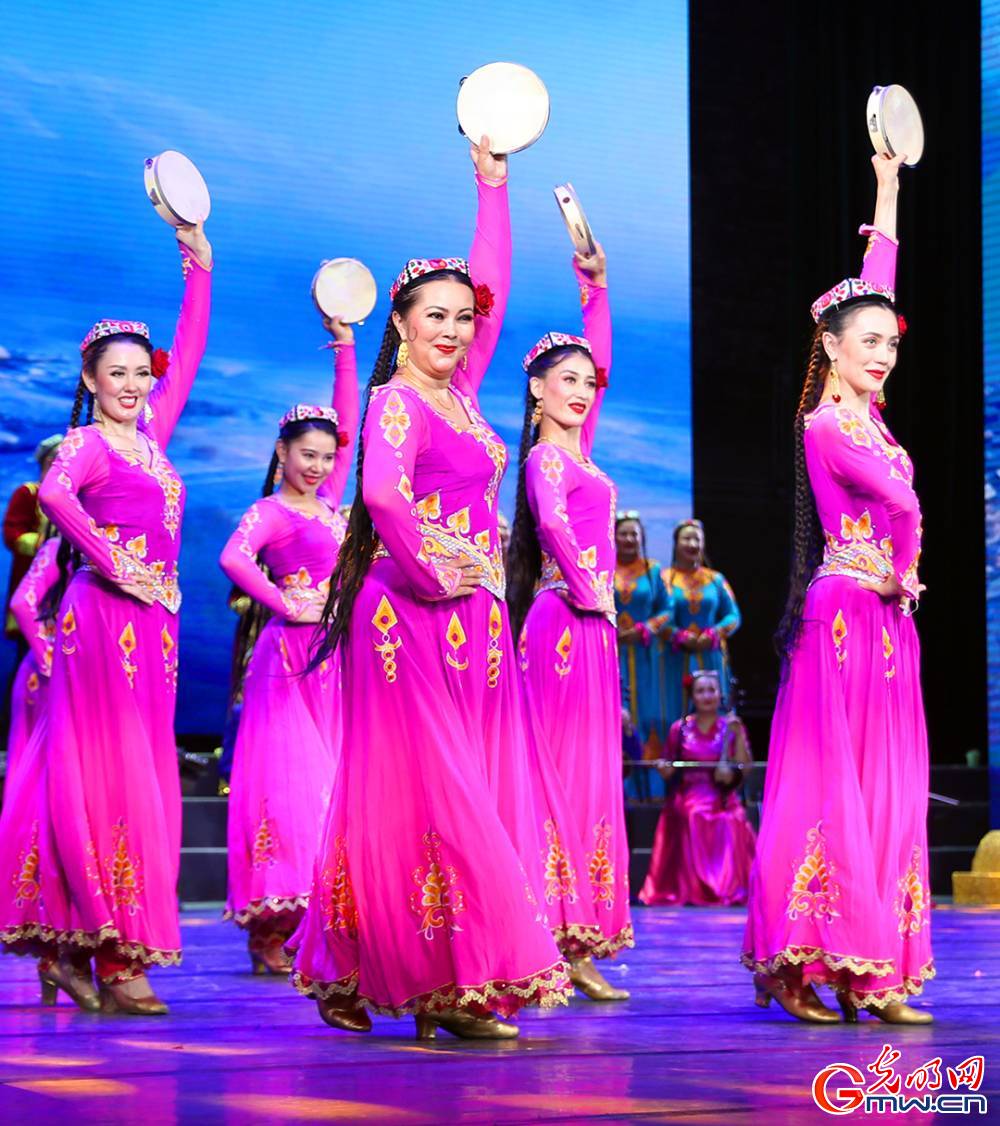
Photo taken on July 30, 2022 shows actress from Xinjiang Art Theater Muqams Art Troupe performing intangible cultural heritage "Twelve Muqams" at the Xinjiang People's Theater in Urumqi, northwest China's Xinjiang Uygur Autonomous Region. (Photo/Guangming Picutre)
Jointly produced by Beijing and Xinjiang, the dance drama “Five Stars Rising from the East” tells the story of a Han Dynasty brocade piece unearthed from Xinjiang that carries the line “Five Stars Rise in the East Favoring China”. The show was a spectacular hit in Xinjiang as it explains the theme that people of various ethnic groups “cling together just like pomegranate seeds”.
In Tacheng’s Qianjin Village, a theme activity captivates local villagers as it involves dances, monologues, quizzes, dumpling-making, bean picking, tug-of-war games, paintings and promotion of local specialties by college graduates via live streaming.
“The strategy of ‘Nourishing Xinjiang with Culture’ is of great significance as it’s an integral part of the Party’s governance approach in Xinjiang in the new era proposed by General Secretary Xi”, according to Zhang Chunlin, deputy party secretary and head of publicity of the CPC Xinjiang Autonomous Region Committee. “We must cultivate people’s minds and pull people together with the profound culture of the country, and consolidate the cultural identity of the Chinese nation”.
Indeed, cultural identity represents the highest level of identification as it underpins ethnic unity and harmony. One of the approaches to enhance cultural identity is to let history and cultural relics speak.
On the vast land of Xinjiang, there are countless legendary stories behind its numerous monuments and cultural relics.
The Jirentai Valley ruins in Nilek County, one of the “Top 10 New Archaeological Discoveries in China” in 2018, is a settlement site from the Bronze Age with great academic value for the study of the chronological staging, genealogy, settlement pattern, social conditions and cultural exchanges between China and the West in the prehistoric period of Xinjiang.
The Shichengzi ruins in Qitai County, one of the “Top 10 New Archaeological Discoveries in China” in 2019, is the former site of “Shule City” where Geng Gong was stationed in 75 A.D. The remnant walls, corner towers, moats and gates showcase the military and political measures introduced in Han Dynasty to govern the northwestern part of the country.
The Kyaikudok Beacon Site in Yuli County, one of the “Top 10 New Archaeological Discoveries in China” in 2021, is a grassroots military administration site along the ancient “Loulan Road” in Tang Dynasty. It proves that as early as Tang Dynasty, the northwestern region had already been under effective jurisdiction of the central government.
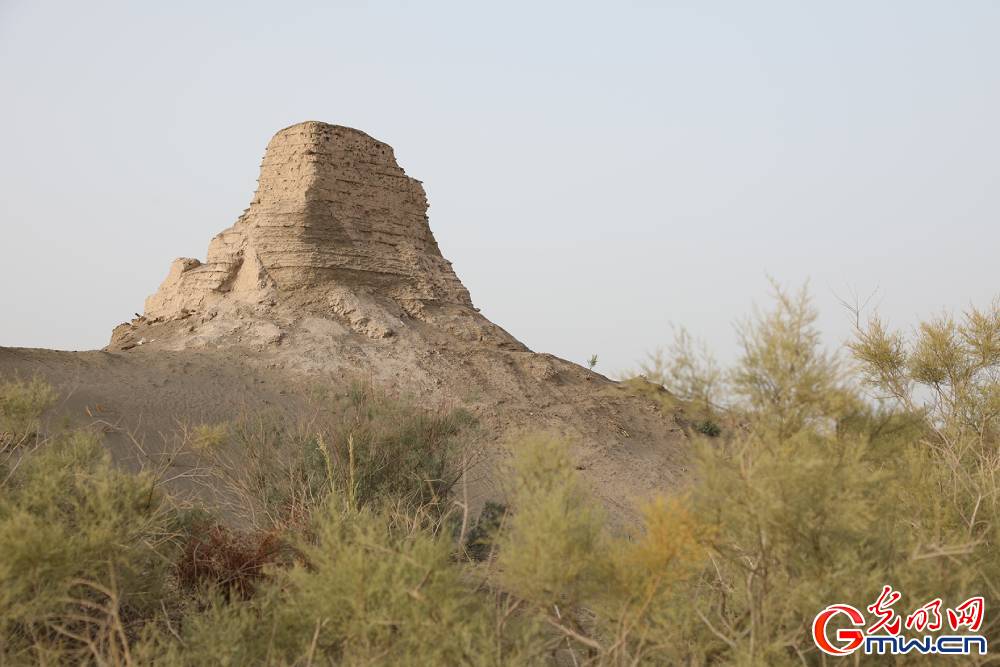
Photo taken onSep. 25, 2021shows the Kyaikudok Beacon Site in Yuli County, Yuli County, Bayingolin Mongolian Autonomous Prefecture, northwest China's Xinjiang Uygur Autonomous Region. (Photo/Guangming Picture)
“Over the years, archaeological discoveries are introduced to all ethnic groups in Xinjiang in a tangible, perceptible and effective way, deepening people’s awareness that Xinjiang has been an inseparable part of China’s territory since ancient times and enhancing the collective identity of the Chinese nation,” said Li Wenying, director of the Xinjiang Institute of Cultural Relics and Archaeology.
At the height of summer, the Nalati grassland in the Ili River Valley is an eyeful of green. On the flat pasture are large flocks of sheep, horses, as well as herdsmen, yurts, streams, bushes and endless rape flowers that attract a steady stream of visitors.
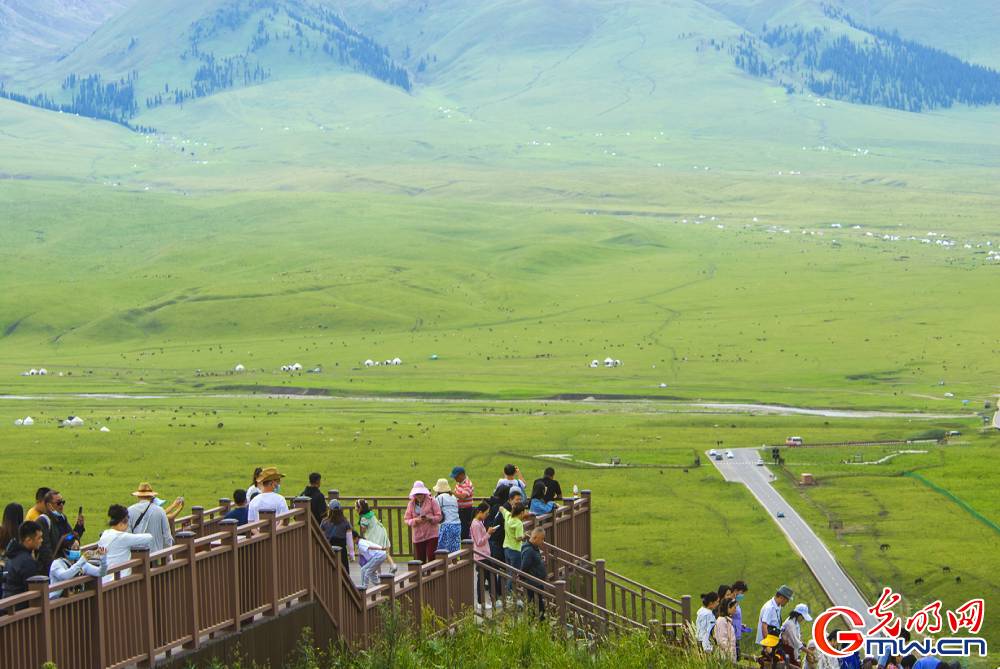
Tourists take photos on the Nalati grassland in Xinyuan County, Ili Kazakh Autonomous Prefecture, northwest China's Xinjiang Uygur Autonomous region, July 11, 2022. (Photo/Guangming Picture)
The melodious and high-pitched song “The Big River” permeates the river valley and grassland, carrying the singer’s love for his hometown to places far away.
Captivated by the beautiful grassland and the positive changes in his hometown, Wan Haitao, a musician in Chengdu, came back to his hometown. Three years ago, he put together a Nalati band of 13 members. Now the band has become very popular in the region. They write and present new songs using electric bass, drum set, as well as traditional instruments dongbula and sebuzik. They also sing classic songs such as “In That Faraway Place”, “Beijing’s Gold Mountain” and “Kangding Love Song” to show the beauty of the grassland and the charm of ethnic culture.
“Although the grassland is not as prosperous as the city, everyone is willing to sing at our hometown,” Wan, the Band leader, said. “We hope to touch more people with our music and enrich the culture of Xinjiang.”
Tourists would interact with the band when it plays music, and behind the joyful crowd one can see the magnificent Tianshan Mountains from afar. It is in this jubilant scene that people can’t help but think, isn’t culture like the water melted from mountains that moistens the land of Xinjiang?
Magnificent yet Distinctive Beauty
Which region of the world is the farthest from the ocean? It is the great desert of Xinjiang!
The Taklamakan Desert is known as the “Sea of Death”. More than half a century ago, a Swiss expedition stepped into this intimidating, barren land, in the end, all died of hunger and thirst except one survivor.
That was then. Today, one would be shocked by the magnificent greenery in this place.
Along the northwest edge of the Taklamakan Desert, there are endless, lush man-made forests that are like giant, green waves. Generations of efforts have turned the Kekeya area of Arksu Prefecture into an oasis.
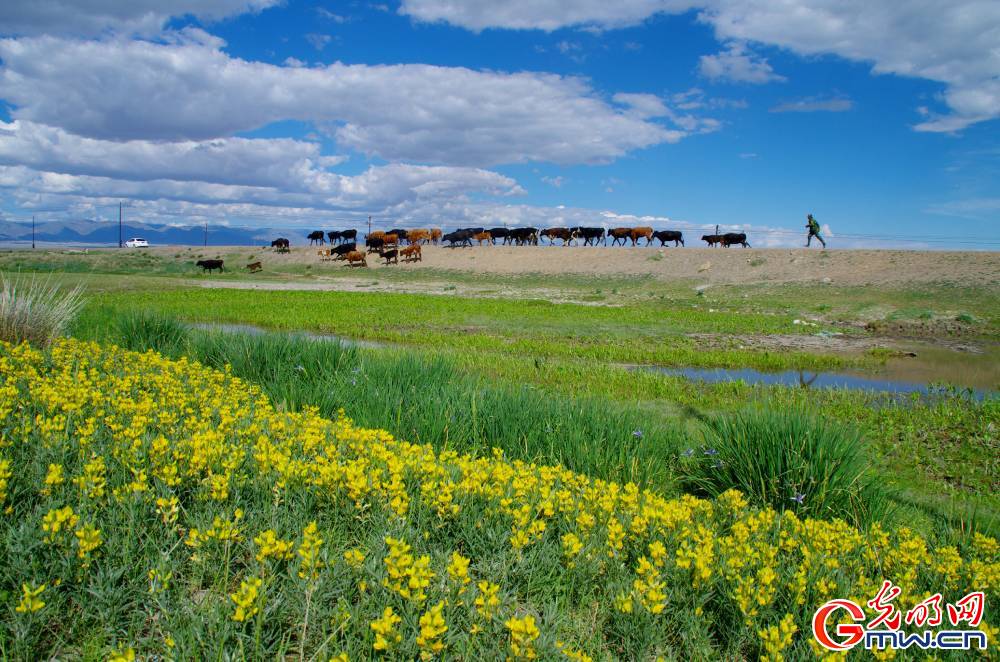
Photo taken on June 7, 2016 shows cattle herd on theBarkol grassland inBarkol Kazakh Autonomous County, northwest China's Xinjiang Uygur Autonomous Region. (Photo/Guangming Picture)
The people in town told us that “Kekeya” means “green cliff” in the Uygur language, which represents the locals’ desire for green oasis. It was here that for thousands of years peoples suffered from strong gales that blew with yellow sands.
More than 30 years ago, the cadres and the people of all ethnic groups in Aksu defied the odds – they dug river channels and planted trees on the barren land despite logistic difficulties. Little by little, the color of green spread out in the desert.
In the Kekeya Memorial Hall, we gained an idea of the amount of investment over the years: 255 million yuan spent from 1986 to 2012, resulting in an afforestation area of 269,700 mu (17,980 hectares); 2.612 billion yuan spent from 2013 to 2020, resulting in 932,900 mu (62,193 hectares) of forest.
The large area of greenery has greatly benefited the Aksu region: annual dusty weather has been reduced from more than 100 days to less than 30, annual precipitation increased from 60 mm to 120 mm, and local farmers’ per capita income from forestry and fruit business has increased from 48 yuan to 5,292 yuan.
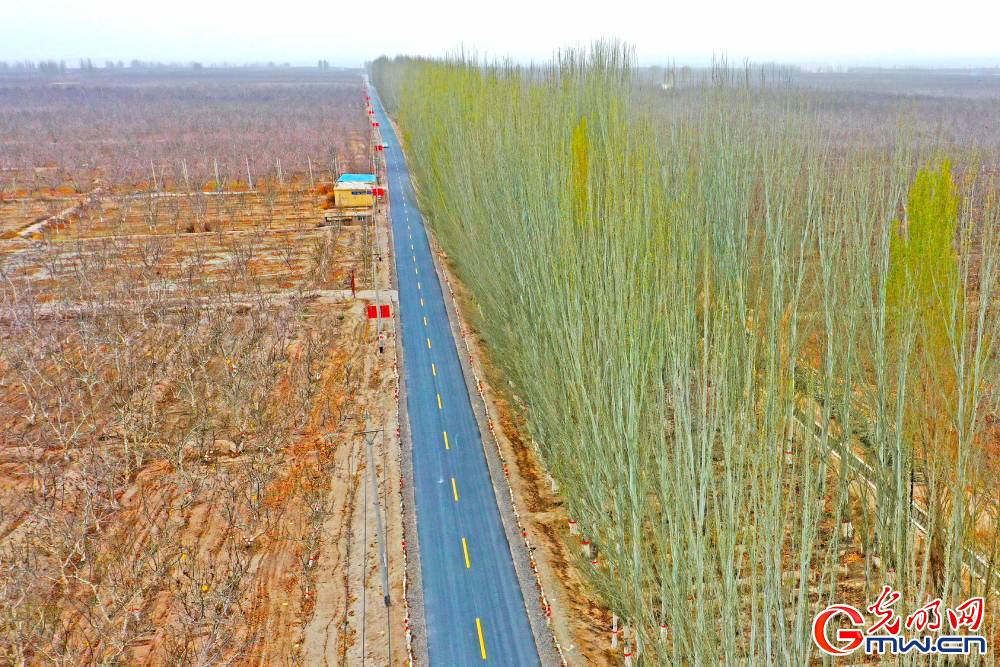
Photo taken on April 5, 2021 shows a greening project in Kekeya Town of Wensu County, northwest China's Xinjiang Uygur Autonomous Region. (Photo/Guangming Picture)
Life has a thousand forms, so do culture and civilization. The green saga of Kekeya is an inspiring example that so long as people respect and take care of Nature, Nature will return the favor with blessings for the people. It is in this way that the Chinese explain its long-cherished belief that “men are an integral part of Nature”.
Hou Xinyu, a senior reporter of Hotan Daily who went with us along the trip, said that in many people’s impression, Xinjiang is just a Gobi land with barely any life. But we’ve seen with our own eyes that those who help themselves get helped.
Seated deep in the hinterland of the Eurasia Continent, Xinjiang has a dry climate with very low precipitation, and a drastic temperature difference between day and night, as well as long sunshine hours. The sunshine of Xinjiang could reach 2,600 to 3,400 hours per year. The excessive sunlight may make people feel uncomfortable, but it provides ample energy for plant growth.
Xinjiang is also characterized by windy days with strong gales that blow with yellow sand. But the wind helps pollinate the flowers and thus enables plants to grow better.
The snowcapped mountains are not only a beautiful scenery decorating Xinjiang’s skyline, but also the water source that moistens more than 143,000 square kilometers of oasis and 1 billion mu (66.67 million hectares) of agricultural, forestry and husbandry land. The closer we get to the mountains, the more grandiose and selfless it looks, and the better we understand that people are just part of this gigantic ecosystem.
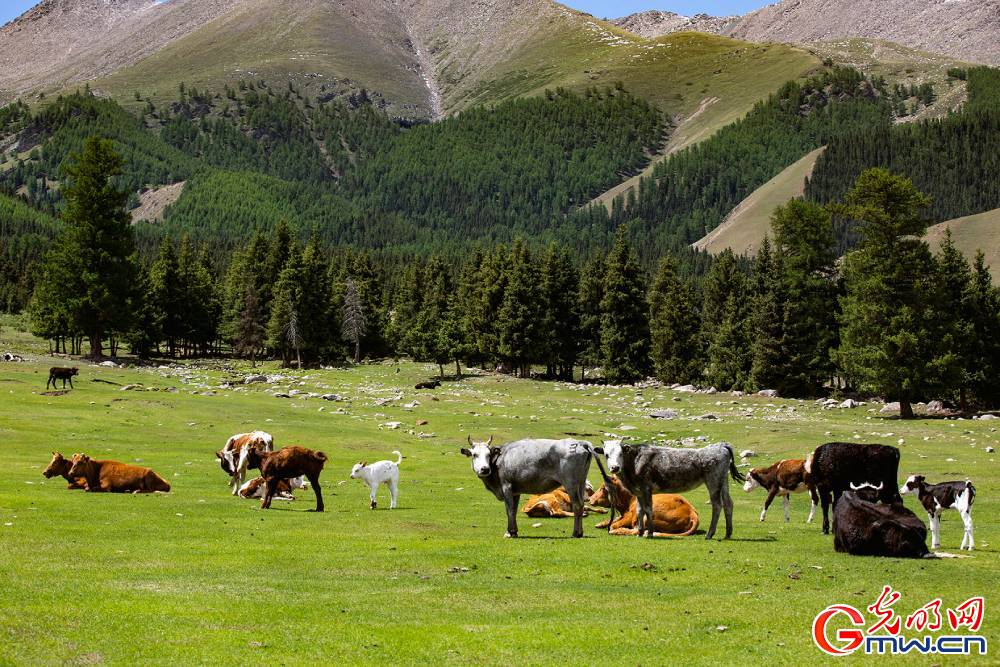
Photo taken on June 4, 2022 showsa picturesque view of Tianshan grassland in Barkol Kazakh Autonomous County, northwest China's Xinjiang Uygur Autonomous region. (Photo/Guangming Picture)
The people of Xinjiang have embraced nature with open arms and created a different scenery with tenacity and unremitting efforts. Today, the lavender in the Ili Valley alone accounts for more than 97% of the country’s total planting area, and together with Provence of France and Hokkaido of Japan, it has become one of the three main producers of lavender in the world. The bazaars of Xinjiang sell over 300 types of fruits such as red dates, walnuts, watermelons and the raisins with the sugar content of 60%. Today, Xinjiang has already become one of the 6 major fruit producers of the world. It’s also a key producer of quality wheat thanks to its ample sunshine and snow water. In 2021, the total wheat yield hit 6.4 million tons. Xinjiang is China’s largest production base of high-quality cotton, and the country’s only producer of long-staple cotton. With a cotton output of 5.13 million tons in 2021, it accounted for nearly 90% of China’s total. Xinjiang also ranks third globally in tomato production and processing, its tomato products are sold to over 100 countries and regions. Besides, Xinjiang is one of China’s five major pastoral areas, delivering top-notch livestock products such as beef and lamb.
No wonder the locals praise their homeland with such lines: “The sky is extremely blue, the flowers are in full blossom, and the girls are stunningly gorgeous”.
Happiness with Passion
Along the trip, we were impressed by the simple wisdom of the people in Xinjiang. Juman Khudaybaygen, a Kazakh man on the Tulgaliao grassland, told us that “Labor brings joy, and solidarity brings victory.”
This is a proverb known to the Kazakh people but was especially felt by Juman Khudaybaygen, who lives in the small county of Yumin, in a herding and farming area. Thanks to the tenacity and solidarity of the locals, today it’s a well-off county where people are leading happy lives. Let the figures speak: with a little more than 50,000 people, the county’s total savings deposits have hit 2.2 billion yuan.
The 66-year-old Juman has moved from the yurt home of Tulgaliao grassland into the town of Aktikche village in Jiangers Township. Herding sheep on the grassland all his life, he told reporters that his family had more than 80 sheep, 8 cattle, and more than 3,000 yuan of monthly pension. “Life is so good these days that I’m also working as a volunteer in my village, I tell the young folks that happiness is the result of hard work.” When asked what else he wished for, he said emotionally, “My biggest wish is to say to the General Secretary myself that the Kazakh people can’t thank him enough!”

Photo taken on June 11, 2022 showsthe magnificent Panlong Ancient Road running through the mountains of the Pamir Plateau like a giant dragon at Kashgar, northwest China's Xinjiang Uygur Autonomous region. (Photo/Guangming Picture)
Walking around Xinjiang, we felt the surging passion of solidarity and tenacity of its people.
To the east is the huge domestic market of 1.4 billion people, and to the west is a large Eurasian market of another 1.4 billion people – Xinjiang enjoys unprecedented development opportunities at a time when China decides to transform its hinterland into the next frontier of domestic development.
In 2020, Xinjiang was given a big “gift package” – a national pilot zone for economic openness was to be built in Tacheng. We drove to the site and was astonished to see the super-large construction scene with roaring machines and high crane towers. Workers from the 15th Division of China Railway Construction Corporation and Sany Group were busy changing the looks of the city.
According to Xiao Zuwen, director of the construction program, a cross-border international land port is being built, which will become a large transportation hub and a modern logistics park in China’s northwest; a new energy innovation park is being built, too, and the super-large wind panels it produces will be exported to Central Asia.
As of the end of July, the pilot zone had signed contracts for 99 projects, worth 84.703 billion yuan, and 51 construction projects had been kicked off.
Yang Liu, member of the CPC Tacheng Committee and its publicity director, said with pride that “In a few years, this will become another Shenzhen, only without the sound of sea waves.”
In southern Xinjiang, leveraging the geo-connectivity advantage and boasting five land ports, the city of Kashgar is a gateway of the Silk Road Economic Belt. Its Special Economic Development Zone has been around for 12 years, and its Comprehensive Bonded Zone has been operational for 8 years, and that’s why the city today boasts a well-developed open economy.
The locals are more than proud of their city, “There is Shenzhen in the east and Kashgar in the west”. Today, Tacheng and Kashgar have taken Shenzhen, vanguard of China’s reform and opening-up, as their benchmark, which shows the determination and ambition of the people of Xinjiang in catching up.
Entrepreneurs in Khorgos are equally, if not more, passionate and enthusiastic about their future.
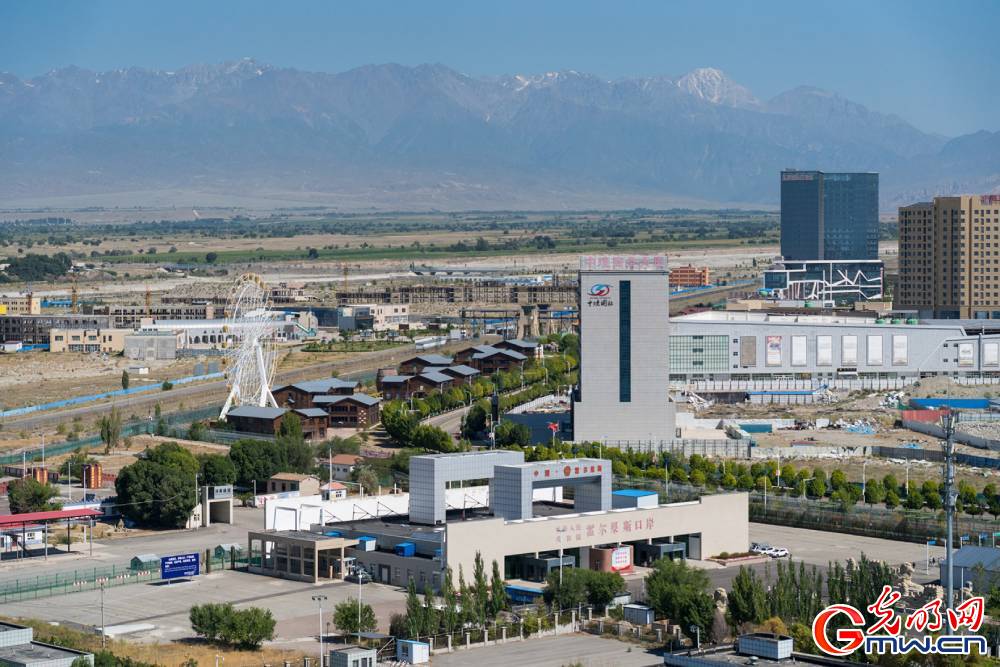
The photo taken on July 22, 2022 shows the Khorgos Port Museum on the China-Kazakhstan border. (Zhang Andi/Guangming Picture)
The 25-year-old Ren Yali serves as the deputy general manager of a digital logistics company in the Comprehensive Bonded Zone responsible for shipping goods from Hangzhou, Yiwu and Shenzhen to Malaszewicz, Poland, via the China-Europe Express Train. Every eight days, containers on the train would come back with made-in-Europe cars. By her calculation, this year’s revenue may hit 2 billion yuan. This modern trade company with only 100 people is writing its own legend thanks to the Belt and Road Initiative.
The 35-year-old Zhang Xiaofeng is the manager of a 3.2-hectare modern greenhouse in the Khorgos Agriculture Industrial Park. The persimmons his greenhouse produces are organic, pollution-free. Four persimmons would weigh 1 kilo, and the harvest season comes three months after planting. According to Zhang, the persimmons are sold not only locally, but also to Sichuan, Shanghai and Fujian, with an annual sales revenue of 40 million yuan.
In Hotan’s Yutian County, we went into the Kulban Tulagi Memorial Hall and met with Kulban’s great-granddaughter, a 27-year-old woman named Rukyamu Maitisai.
The story of Uncle Kulban riding a donkey to Beijing has been extolled for generations. Kulban, a Uygur farmer who survived the hardships of the old society, was able to live in his own house and harvest his own farm immediately after the founding of New China. Kulban was so grateful to Chairman Mao that he handpicked the best dry-fruits and carried them to Mao riding his donkey. The photo of his handshake with Chairman Mao was later known by the entire nation.
“That journey of my great-grandfather-in-law was filled with twists and turns. In the autumn of 1955, he took hundreds of naan bread with him and set out on a donkey journey to Beijing, but after seven days and nights, he realized he was still in the Hotan area”, Rukyamu Maitisai told our reporters.
Rukyam Maitisai became one of the first passengers of the Hotan-Ruoqiang Railway after the line was put into operation in 2022. She said to her great-grandfather-in-law in her heart that “Yutian county today is much closer to Beijing”.
With a total length of 825 kilometers, the Hotan-Ruoqiang Railway stretches along the southern edge of the Taklamakan Desert, and 534 kilometers of the railway line are in windy desert areas, making it the world’s first railroad along a desert. Chairman of the railway line Wang Jinzhong said that after more 1,300 days of working in extreme conditions against harsh gales and scorching sun, the line was eventually opened in June this year. It marks yet another miracle written on the “Sea of Death”.
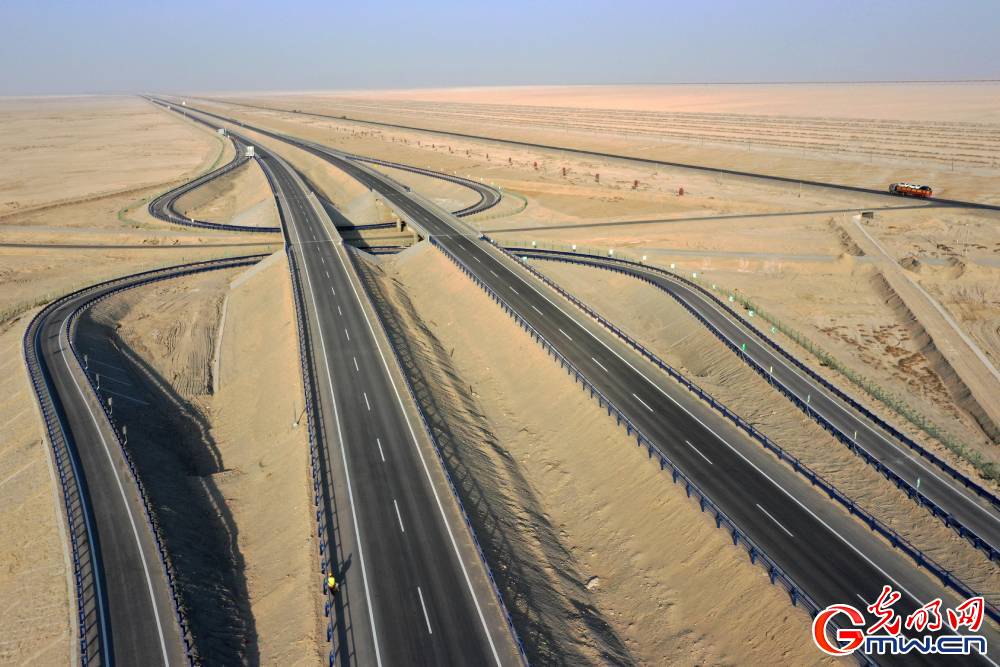
Photo taken on Dec 29, 2021 shows G0711 Yuruo highway in Ruoqiang County, Bayingoling Mongolian Autonomous Prefecture, northwest China's Xinjiang Uygur Autonomous Region. (Photo/Guangming Picture)
The development of Xinjiang is the result of the successive struggles of the people of all ethnic groups in Xinjiang, as well as the sincere and staunch support from 19 other provinces and cities. During the 13th Five-Year Plan period, 19 provinces and cities invested a total of 75.965 billion yuan in Xinjiang, 8,519 assistance projects were carried out, and more than 13,000 officials and professionals were dispatched to help Xinjiang.
At the Shandong Provincial Aid Command in Kashgar, we met with general director Zhang Chengwei and his team. Zhang was very familiar with Shandong’s assistance to Xinjiang: Since the 13th Five-Year Plan, Shandong has invested 9.66 billion yuan in aid to Xinjiang. Shandong has built 27,800 houses, benefiting more than 111,000 people; Shandong Water Development Group invested 1.06 billion yuan in Shule County and set up the 5,000-mu (333.33-hectare) modern vegetable park in Southern Xinjiang. Zhang is especially proud of the Shandong watermelons re-planted in Kashgar. The famous “Guo watermelon” is sold at 100 yuan per kilo, and its annual output is expected to reach 136 million yuan. Zhang has been working in Xinjiang for four years, he enjoys his work despite his tanned face. The Uygur elder sister he befriended was once bedridden, and after his enthusiastic help, she was able to walk again. Members of his team have befriended Uygur people and they’re truly like one family.
Not all stories in Xinjiang are grand ones like what we’ve just told. Many ordinary folks are pursuing their dreams here, and they are the beautiful scenery of this great era.
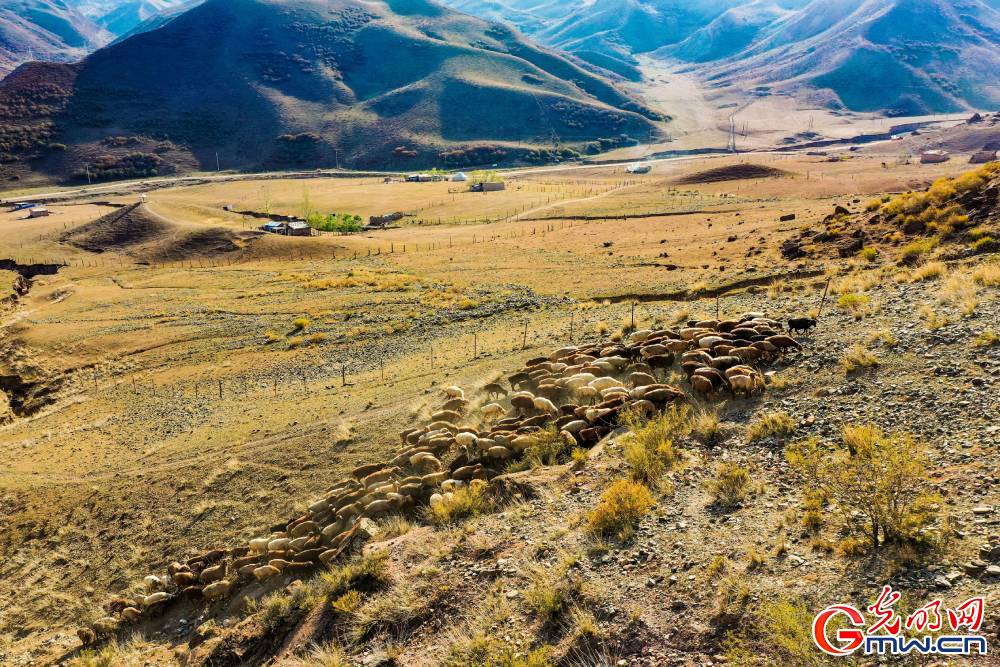
Photo taken on Sept 19, 2022 shows alarge number of sheep are moving in the southern mountains of Hutubi County, Changji Hui Autonomous Prefecture, northwest China's Xinjiang Uygur Autonomous region. (Photo/Guangming Picture)
Story 1: 30-year-old Duoleti Tursunyaz is a happy young man because Re is a farmer-turned-worker. His hometown, Luopu County, is located at the southern end of the Taklamakan Desert, which was once one of the most impoverished counties in Xinjiang. Things changed a few years ago when the county built an industrial park, allowing more than 8,000 people to work near their homes, and Duoleti was one of them, earning nearly 3,000 yuan a month. His biggest wish is to send his children to a good school.
Story 2: 42-year-old Yakov Tuldi was a down-to-earth herdsman. His hometown, Taglak Village of Aksu’s Wensu County, is located at the foot of the main peak of the Tianshan Mountains – the Tomur Peak. Though bestowed with beautiful natural scenery, villagers had long been begging for food. In 2019, Wensu County and Aksu Cultural Tourism Group co-invested hundreds of millions of yuan there to build a train theme park, a ski resort, and a pedestrian street with restaurants on both sides. Entertainment programs such as helicopters, hot air balloons, powered parachutes were also introduced to the complex. Today, the annual tourism revenue has reached 40 million yuan. Yakov has become a ticket inspector at the tourism compound, earning 4,200 yuan per month. The biggest wish of Yakov is to start his own homestay business.
Story 3: 36-year-old Mabeckli looks much younger than his age, which he says is because the Xinjiang lamb nurtures people well. Twelve years ago, Mabeckli migrated to Ilitex County from Gansu Province. With skills and experience in the catering industry, he opened a small restaurant in a street corner specializing in sliced lamb and noodles. He picks the best lamb every morning and constantly improves his recipe. Before long, he was well recognized by gourmets. During the peak tourist season, his restaurant could receive more than 1,000 customers each day, with daily revenue exceeding 80,000 yuan. Today, the restaurant is shorthanded even with over 30 staff members. Mabeckli’s biggest dream is to scale up the restaurant by one fold, and open a few branches.
Story 4: Wang Wei is a millennial who likes poem-writing. Three years ago, she and her friends came to Kashgar on a trip and fell in love with the city immediately. She rented two houses along the streets the day she finished the trip. A few months later, she quit her job and returned to Kashgar, where she opened the “Moonlight Hostel” and “Moonlight Coffee” – she has since developed a deep bond with the local residents. Wang Wei just harvested a successful business season this summer. She wishes to see her business grow a little bigger in the future. …………

Photo shows the ancient city of Kashgar, northwest China's Xinjiang Uygur Autonomous Region. (Photo/Guangming Picture)
After more than 10 days of separate trips, the research team re-assembled in Kashgar when its 10,000-mu pomegranate orchard entered its harvest season. It’s the shared belief of all members of the team that the people living in the land of Xinjiang will realize their dreams and have better lives!
